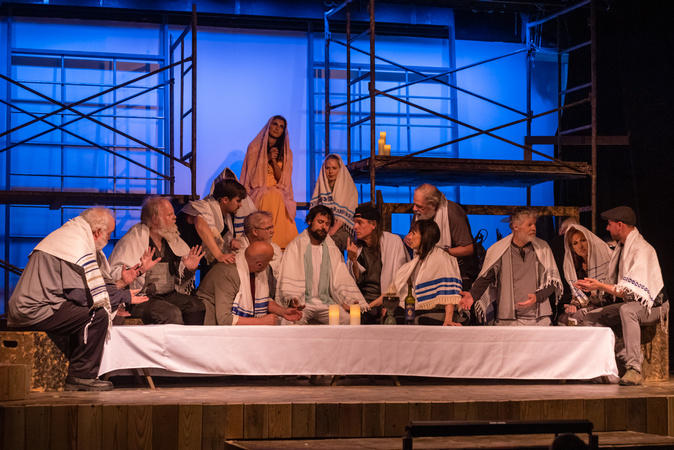
“The Last Supper” scene in CHT’s production is here recreated with reflections of the famous painting by Leonardo da Vinci – Church Hill Theatre 2019 production of “Jesus Christ Superstar” Photo by Steve Atkinson
Church Hill Theatre’s production of Jesus Christ, Superstar is a remarkable testimony to the depth and quality of theatrical talent in the local area. Directed by Shelagh Grasso, the production runs through June 23. Anyone who follows musical theater should make it a point to attend. The show is currently sold-out for its entire run. However, if you don’t already have reservations, just show up for one of the three remaining performances and ask to be on a wait-list. There are always some no-shows and the theatre has been able to seat a number of extra people at each performance.
From its appearance in 1970 as a “rock opera” concept album with music by Andrew Lloyd Webber and lyrics by Tim Rice, Superstar challenged preconceptions. A musical dramatization of the last week of Jesus’ life, it attracted attention simply for its subject matter, especially because of the often ironic take on the characters’ motivations and attitudes – notably its sympathetic treatment of Judas. Originally banned by the BBC for being “sacrilegious,” the album became an international bestseller, with more than 7 million copies sold by 1983.
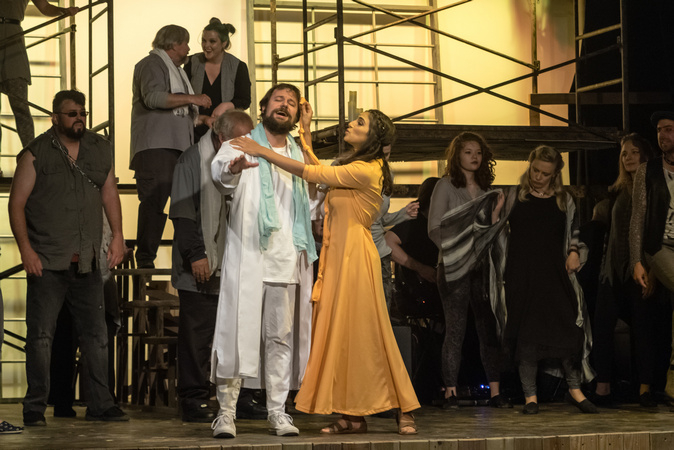
Jesus (Mark Weining) with Mary Magdelene (Stav Pinder) and a crowd of followers.
The album’s success led to its opening as a Broadway musical in October 1971. The cast included Jeff Fenholt as Jesus, Ben Vereen as Judas, and Bob Bingham as the Jewish High Priest Caiaphas. Yvonne Ellman as Mary Magdalen and Barry Dennan as the Roman governor Pontius Pilate reprised the roles they sang on the original album. Carl Anderson, who had the role of Judas on the album, replaced Vereen when he fell ill, with the two alternating in the part after Vereen’s recovery. The Broadway production ran for 711 performances. The show failed to win a Tony Award, despite racking up five nominations, but Lloyd Webber received some recognition in the form of a Drama Desk award as “Most Promising Composer.” The play opened in London’s West End in 1972 and ran for eight years straight – London’s longest-running musical at the time. Superstar was the third collaboration between Webber and Rice, who both went on to become major figures in the modern musical theater, with such hits as Evita, Cats, and The Phantom of the Opera — just to name a few — to their credit.
Superstar was made into a film – shot in Israel and other Middle East locations – in 1973, with several of the Broadway cast again reprising their roles. A second film version, released as a video only, was shot in 1999 and broadcast on PBS’s “Great Performances” in 2001. And on Easter Sunday 2018, NBC produced a widely-acclaimed live concert version of the play, with John Legend in the role of Jesus.
So Church Hill’s production has high expectations to fulfill. As Grasso said following the opening night performance, the local theatrical community came together in several months of hard work and pulled off a stunning performance.
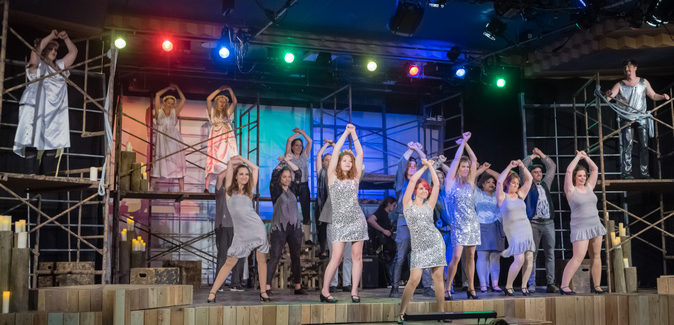
The choreography by 2016 Washington College graduate Kendall Davis is spectacular.
The “rock opera” designation is accurate in the sense that the dialogue is almost entirely sung – only a few lines are actually spoken. It is also accurate in that the vocal demands on the main characters, as far as range and projection, go a good bit beyond the average musical. So all the main roles need to be in good singing voice, and in addition, there is a significant element of choreography in many of the roles. The cast — which covers an age span from a 13-year-old to several in their 70s — makes it all work. It’s as powerful a piece of musical theater as this area has seen in a long time.
Mark Weining, who plays Jesus, is visually an excellent choice for the role. He looks like Jesus! And his voice and acting chops – developed in numerous roles at CHT – are up to the challenge. The dramatic demands of the part – possibly the single most significant figure in the history and culture of the last two millennia – are obvious: the actor must walk the line between deep sympathy for the problems of the poor and oppressed and the authority of a major prophet – perhaps even a god incarnate. And in the second act, after his arrest, the role of martyr becomes predominant, with all the attendant physical pain and psychological doubt. Weining brings it all off powerfully.
The role of Judas is central to the play, and Max Hagan does a fabulous job. Both in his vocal numbers and in his acting, he brings a strong presence to the role. High energy and passion. Keep an eye on him even when he is to the side of the stage – his reactions to what Jesus and his followers are doing are as important to the overall plot as what is happening in the center of things. Hagan stands out – as he should. Note that he is dressed in red and black while Jesus is in a pure white robe and his followers and the various other characters wear shades of black and white but mostly gray. It is not coincidental. Hagan shows how Judas is genuinely concerned about the direction Jesus’s movement is taking and Judas fears that it will lead to more persecution and oppression of the Jewish people by the Roman authorities. Judas also thinks that by betraying Jesus, he is fulfilling a prophecy and that Jesus understands, even wants, the prophecy to be fulfilled. This Judas does not want “Blood Money” and is in agony when he begins to understand that he has been used by the high priests to help them get rid of a “problem”.
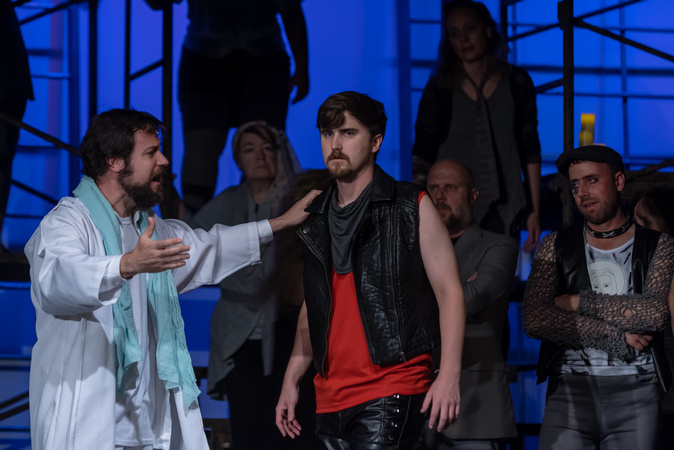
Jesus (Mark Wiening) and Judas Iscariot (Max Hagan) with Peter (Bob McGrory) and Simon Zealotes (Nevin Dawson)
Stav Pinder takes the role of Mary Magdalene. She is a delight. Her strong singing voice shows to good advantage in the show’s big ballad, “I Don’t Know How to Love Him.” And as the show’s single significant female character, her role takes on greater importance. Her training and experience in opera are clearly visible. Her ability to interpret a song, not just hitting the notes but bringing emotion and meaning to the lyrics, is highlighted in songs such as “Could We Start Again, Please” and “Everythings’s Alright.”
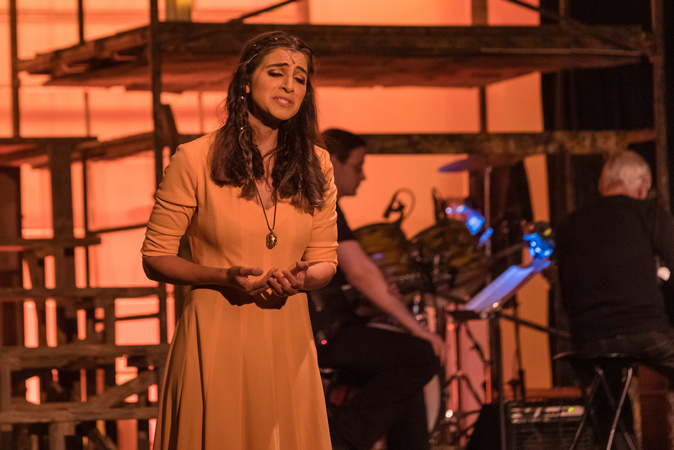
Stav Pinder as Mary Magdelene, sings one of the most beautiful melodies in the show, “I Don’t Know How to Love Him.”
Doug Porter and Brian Whitaker are well cast as the high priests Caiaphas and Annas. They are appropriately sinister and imposing – and they sing their roles well. Porter’s low voice is just right for lines such as “We need a more permanent solution to our problem.” And it sends absolute chills down the spine when they join together with other male voices–including Ken Gresh, David Ryan, and Goldey Vansant–to intone “This Jesus must die, must die, must die.” CHT stalwart Matt Folker is also well cast as Pontius Pilate, the Roman governor who “washes his hands” of the decision to condemn Jesus to crucifixion. Folker ably conveys Pilate’s inner conflict; his reluctance to punish–or worse yet, crucify–what he considers an innocent man. But the crowd demands crucifixion.
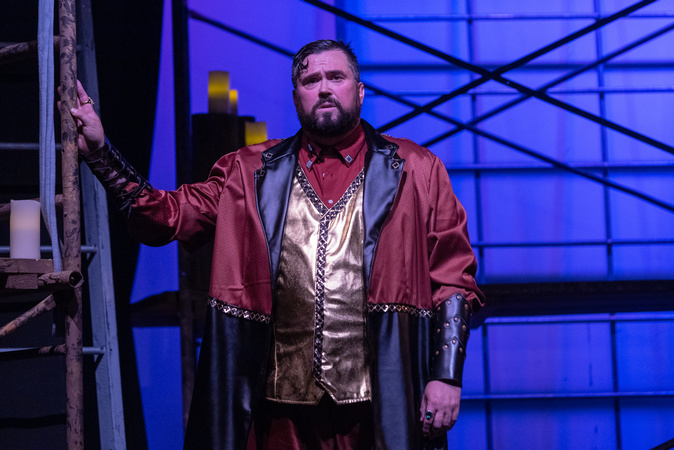
Matt Folker as Pontius Pilate – Church Hill Theatre 2019 production of “Jesus Christ Superstar”
Bob McGrory is very good as the apostle Peter, who pledges his fidelity to Jesus, then denies him three times after Jesus is arrested by the Romans. McGrory also has a fine voice that blends beautifully with Pinder’s in the duet part of “Could We Start Again, Please.” Nevin Dawson plays Simon Zelotes, who tries to persuade Jesus to ignite the Jews to rebel against Roman oppression. His solo is one that really rocks the crowd with piercing “yips” and “yelps” about the “power and the glory” that Jesus will bring. The crowd here does a wonderful dance routine that ends with both Jesus and Simon on high platforms and the crowd raising their arms in jubilation.
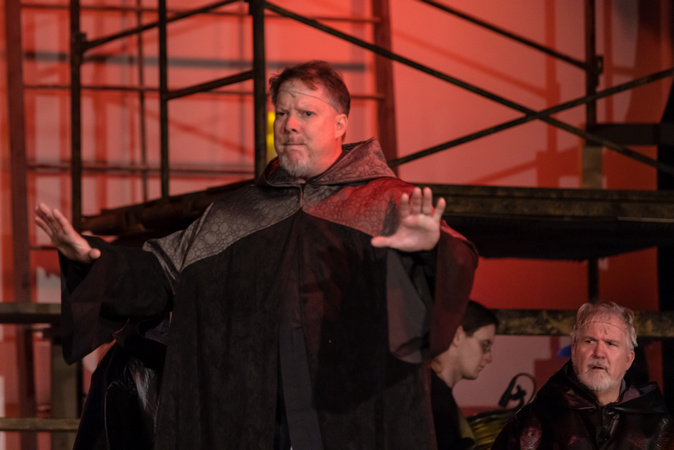
Doug Porter as the High Priest Caiaphas
Speaking of the dance scenes, Greg Minahan, who polished his dancing chops with the Broadway musical Cats, gets a show-stopping number as King Herod, coming across as a slick hustler leading a chorus of floozies in a soft-shoe number – one of the show’s best bits of theater. Minahan deftly tosses his hat and cane to one of the guards and joins the chorus line of dancers. It got laughter and thunderous applause on opening night.
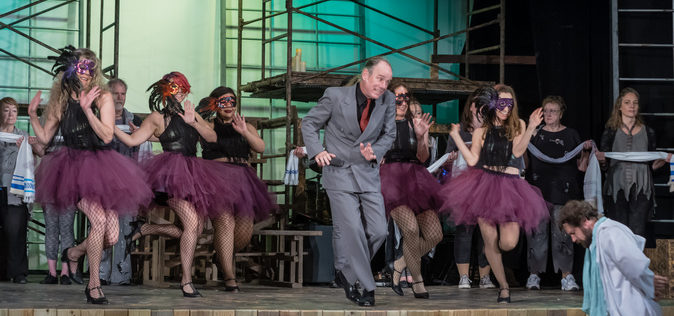
Greg Minihan as Herod with his chorus line.
A lot of the impact of the show depends on the ensemble — at many points, there are some 30 bodies on stage, dancing, adding their voices to the chorus, reacting and interacting with the main characters, and adding spectacle and considerable emotional power to any given scene. A good number of the ensemble members have at one point or another been in lead roles themselves in other shows, both here and in bigger venues. And several say in their cast bios that performing in “Jesus Christ Super Star” is a “bucket list” item for them. That level of commitment comes across in the performance. There are too many such crowd scenes to mention all but a good example of this is the Temple scene where Jesus throws out the greedy money lenders and then is surrounded by a crowd of lepers, all desperately hoping for a miracle. The lepers–including Heather Byers, Connie Fallon, Jane Jewell, Helen Vansant, and Fred Welsh– creep, crawl, stumble, and limp onstage frantically trying to touch the hem of Jesus’ robe. Watch for Natalie Lane, Melissa McGlynn, Laura McGrory, Colleen Minahan, Shayla Moore, Krista Roark, Becca Van Aken, and several others who are absolute dancing dervishes in multiple scenes. Kudos to all.

At the temple, a group of lepers approaches Jesus with hopes of a cure.
The “community” tag is especially apt in that many family groups are part of the cast. Bob, Laura, and Maya McGrory are father, mother, and daughter. Greg and Colleen Minahan are a brother-sister team., both of whom have worked professionally on stage and screen. Matt Folker and Becca Van Aken are a husband-wife team, as are Goldey and Helen Vansant. Folker and Van Aken met and married at Church Hill Theatre–literally. After several years of acting in various productions together, the couple staged their own wedding ceremony right there on the CHT stage. And the family connections extend to behind the scenes as well, with director Grasso’s husband Carmen doing set construction and their son Chris doing sound design. Chris Grasso brought the impressive professional sound system used in Superstar from Upper Darby, PA, where he is a chemistry teacher who moonlights as a sound technician. Chris Grasso will also be providing sound equipment and assistance for this summer’s Green Room Gang productions. Stage Manager Michelle Christopher brought in her husband Speedy for set construction and their son Speedy Jr. to operate the light board, and a second, younger son was frequently on hand during rehearsals, running errands and helping out. And Erma and Tina Johnson, who worked on costumes, are sisters-in-law, married to two brothers, one of whom, actor and singer Jim Johnson, is on stage as one of the apostles.
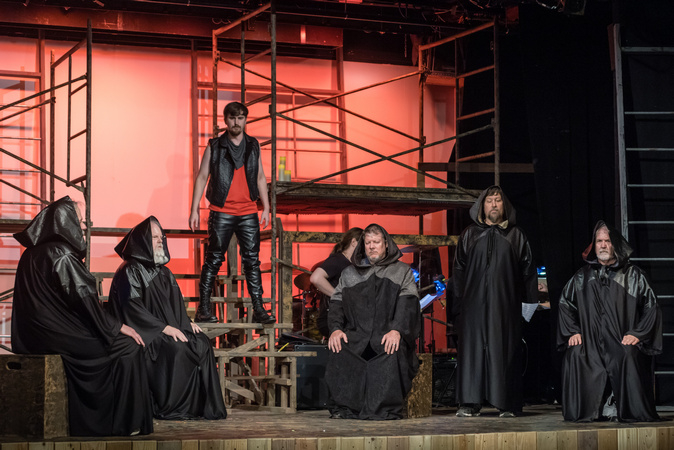
Judas goes to the high priests to tell them where to find Jesus.
The rock quartet that provides the musical foundation for the show consists of Tom Anthony on bass guitar, Helen Clark on keyboards, Frank Gerber on drums and Quinn Parsley on lead guitar. They make up a driving band, with Anthony’s bass lines often carrying the main melody line and Parsley adding a visual “rock star” flourish at various points. If you wonder how they kept it all together musically, adjusting on the fly to variations in each performance, listening for cues, waiting for entrances or audience laughter and applause to subside, well, they are being guided by the show’s musical director, Julie Lawrence, who is keeping time and directing it all from just off stage where the band and most of the singers can see her but the audience can’t. An impressive job by all.
The set, designed by director Grasso and her husband Carmen Grasso, is a large set of scaffolding occupying the entire width of the stage and rising three levels. With the large cast filling it for many of the production numbers, it gives the performance weight and depth that emphasizes the significance of the action taking place. A nice example of “less is more.”
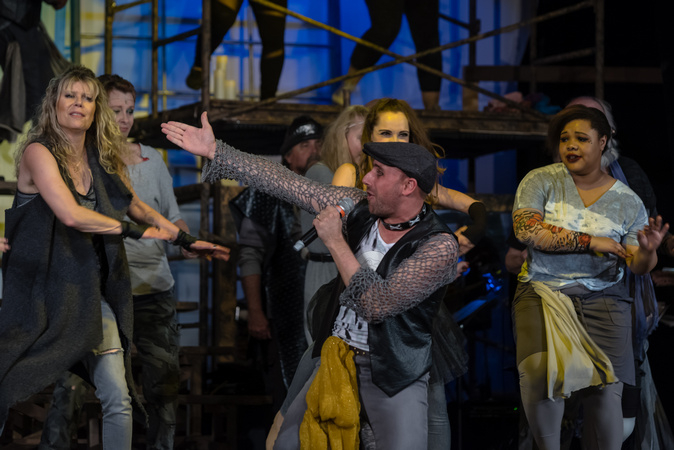
Nevin Dawson as Simon Zealotes
Tina Johnson, Erma Johnson, and Debra Ebersole deserve much credit for the costumes, which cover a range from period-believable robes to punk modern and several stages in between. And Kendall Davis, a recent Washington College graduate, took on the choreography for the show — no easy task, given the age range and the varying levels of experience of the cast, but the results are spectacular.
As a musician myself, I am more of a jazz and blues man but the performance of the music in Jesus Christ Superstar was outstanding. If you can possibly see it, do so. There are occasional points where one actor or another is weak on the high notes, or where the lyrics are hard to hear over the band. However, I was sitting on a back row aisle seat and found that even there I was able to easily follow 90% or better of the lyrics/dialogue – which is about as good as you can get with any production whether onstage, in a movie theatre, or even at home watching TV (where we always turn on the subtitles!). This kind of clarity requires careful and precise enunciation and practice, practice, practice so that 30 people are always singing the same note and pronouncing the same words clearly at the exact same time. How many times have you seen a play or movie and half the time couldn’t understand certain characters who slurred or mumbled or spoke too quickly? This ensemble does not suffer from that common problem, for which great credit is due to director Grasso and musical director Julie Lawrence. All the principal characters had individual mics which also makes a big difference.
The pace of the show is fast with quick scene changes covered by music and hardly any blackouts. The stage lighting, designed and programmed by Kat Melton, is used very effectively to establish both the setting and the mood. A scene may start with bright blue lighting and then morph to gold or pale reddish orange. The final scene, the crucifixion, is done basically with lighting variations including the projection of a cross in a halo of light. It is very effective, though I felt it went on a bit too long. That, however, is a fact of the script and the score and not a flaw in this production. In fact, this reviewer, at least, didn’t find any major flaws in the performance as a whole. It’s a must-see production of a world-famous show.
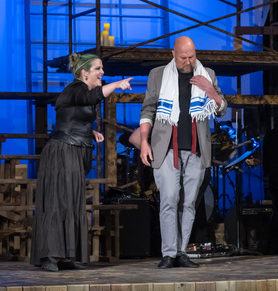
Peter denies that he ever knew Jesus. (Sarah Ensor and Bob McGrory)
Superstar will be playing through June 23; performances are at 8 p.m. Friday and Saturday, with Sunday matinees at 2 p.m. According to the theater, all performances are sold out; however, come to the theater as there are always people with reservations who fail to appear. Reservations that are not picked up by 10 minutes before curtain will become available. So don’t be late if you do have reservations! Tickets paid for in advance will not be given away, so don’t worry if you get caught in traffic. If you do need to cancel, please let the box office know. Admission is $20 for the general audience, $15 for CHT members and $10 for students. Call the theater at 410-556-6003, or visit the theater website.
All photos by Steve Atkinson, courtesy of Church Hill Theatre
###



Write a Letter to the Editor on this Article
We encourage readers to offer their point of view on this article by submitting the following form. Editing is sometimes necessary and is done at the discretion of the editorial staff.